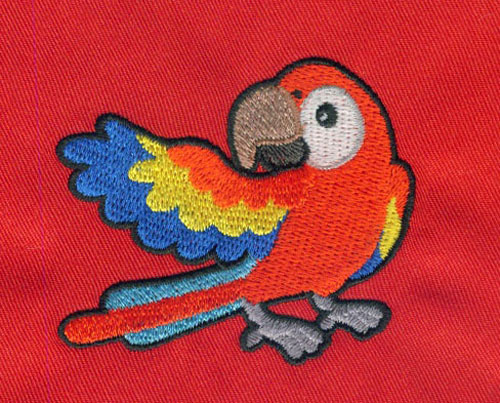Appliqué Embroidery: Mastering the Art of Layering Fabrics with Precision
Embroidery has long been celebrated as a timeless craft, and within its diverse techniques, appliqué embroidery stands out as a captivating art form. Appliqué involves layering fabrics to create intricate designs, adding depth and dimension to your textile creations. In this comprehensive guide, we will delve into the world of appliqué embroidery, exploring its rich history, essential techniques, and tips for achieving precision in layering fabrics.
Unraveling the History of
Appliqué Embroidery
Ancient Origins:
● Appliqué has ancient origins, with evidence of its practice dating back
thousands of years. In cultures around the world, artisans have employed this
technique to embellish garments, ceremonial textiles, and even religious
artifacts.
Cultural Significance:
● Different cultures have embraced appliqué for its unique ability to tell stories and convey cultural symbols. From Hawaiian quilts to West African textiles, appliqué has played a crucial role in preserving and expressing cultural heritage.
Essential Tools and Materials
Fabric Selection:
● Choose fabrics that complement each other in terms of color, texture, and
weight. Cotton, felt, and silk are commonly used for appliqué due to their
versatility and ease of manipulation.
Thread:
● Quality embroidery thread is
essential for achieving precise and durable appliqué. Select a thread that
matches the color of your fabrics or opt for contrasting colors to create
visual interest.
Needles:
● Appliqué needles are specially designed with a sharp point and a small,
round eye. These needles facilitate smooth stitching through multiple layers of
fabric without causing damage.
Scissors:
● Invest in sharp, fine-tipped scissors for cutting intricate shapes.
Precision in cutting is crucial for achieving clean and professional-looking
appliqué designs.
Stabilizer or Interfacing:
● Depending on the project, use stabilizers or interfacing to provide support to the fabric and prevent puckering. They are particularly useful when working with lightweight or stretchy fabrics.
Basic Appliqué Techniques
Raw-Edge Appliqué:
● In raw-edge appliqué, fabric pieces are stitched onto the base fabric
with the edges left exposed. This technique creates a rustic and textured look,
perfect for projects with a casual or playful vibe.
Turned-Edge Appliqué:
● Turned-edge appliqué involves folding the edges of the fabric before
stitching them to the base fabric. This technique results in a clean and
polished appearance, suitable for more formal or intricate designs.
Reverse Appliqué:
● In reverse appliqué, a design is created by layering fabrics and cutting away sections to reveal the layers beneath. This technique adds depth and visual interest to the finished piece.
Achieving Precision in Layering
Fabrics
Template Creation:
● Begin by creating accurate templates of your design on paper. These
templates will serve as guides for cutting the fabric pieces with precision.
Use tracing paper or transfer pens to transfer the design onto the fabric.
Cutting Techniques:
● Take your time when cutting fabric pieces, especially if your design
involves intricate shapes. Use small, sharp scissors to navigate curves and
fine details. Accuracy in cutting directly influences the final result of your
appliqué.
Layering Order:
● Consider the layering order of your fabric pieces to achieve the
desired visual impact. The order in which you place different fabrics creates
depth and dimension in your appliqué design. Experiment with layering to find
the most appealing arrangement.
Pin or Baste Layers:
● Before stitching, pin or baste the layers in place to ensure they
remain aligned during the embroidery process.
This step is crucial for maintaining precision and preventing any shifting that
could compromise the design.
Stitching Techniques:
● Select the appropriate stitching technique based on your appliqué
style. Blanket stitch, satin stitch, and straight stitch are commonly used for
securing fabric layers. Practice your chosen stitching technique on scrap
fabric before starting your main project to refine your skills.
Detailing with Embroidery Stitches:
● Elevate your appliqué by incorporating embroidery stitches for added detailing. French knots, seed stitches, and chain stitches can enhance the overall texture and visual appeal of your layered fabric design.
Advanced Appliqué Tips
Experiment with Fabric Types:
● Mix and match different fabric types to add texture and interest to
your appliqué. Combine matte and shiny fabrics or experiment with patterns and
prints to create unique and eye-catching designs.
Incorporate Embellishments:
● Elevate your appliqué projects by adding embellishments such as beads,
sequins, or embroidery floss. These additional elements can enhance the overall
aesthetic and make your design truly stand out.
Create Dimension with Layering:
● Play with layering to create a sense of dimension in your appliqué. Use
lighter colors or patterns in the background and reserve darker or more vibrant
fabrics for the foreground to make elements pop.
Consider Negative Space:
● Pay attention to negative space in your design. Sometimes, leaving areas without appliqué can be just as impactful as layering fabrics. This approach allows the eye to appreciate both the intricate details and the simplicity of the negative space.
Conclusion
Appliqué embroidery
is a versatile and timeless craft that allows you to layer fabrics with
precision, creating stunning designs that captivate the eye. From ancient
cultural traditions to modern textile art, appliqué continues to be a cherished
technique that adds depth and dimension to a wide range of projects. Whether
you're a beginner or an experienced embroiderer, the key to mastering the art
lies in patience, practice, and a keen eye for precision. So, dive into the
world of appliqué, experiment with layering fabrics, and watch as your
creations come to life with vibrant texture and exquisite detail.



